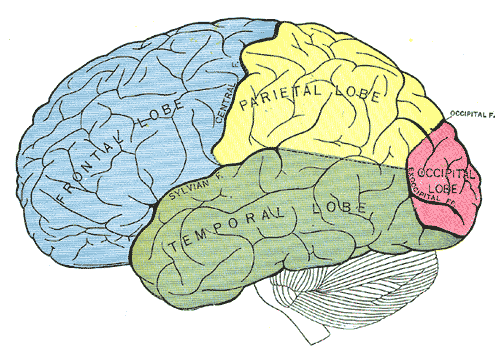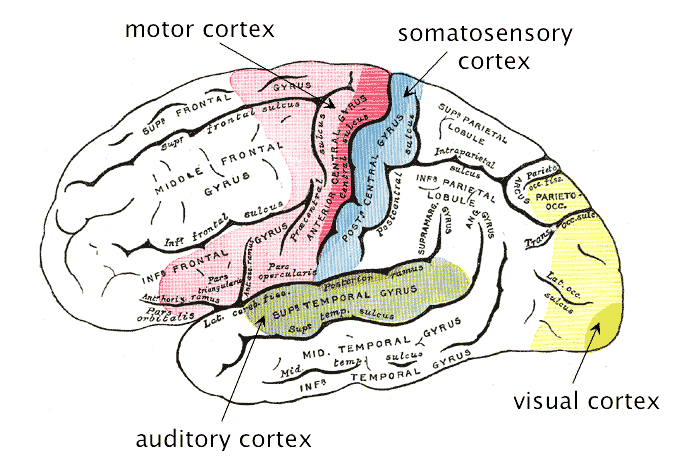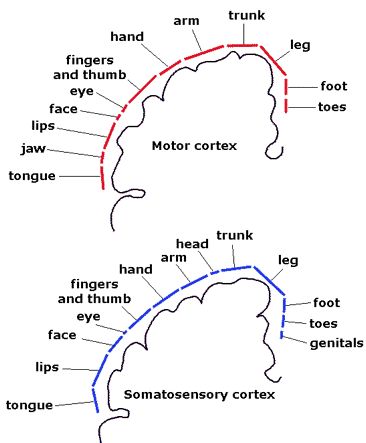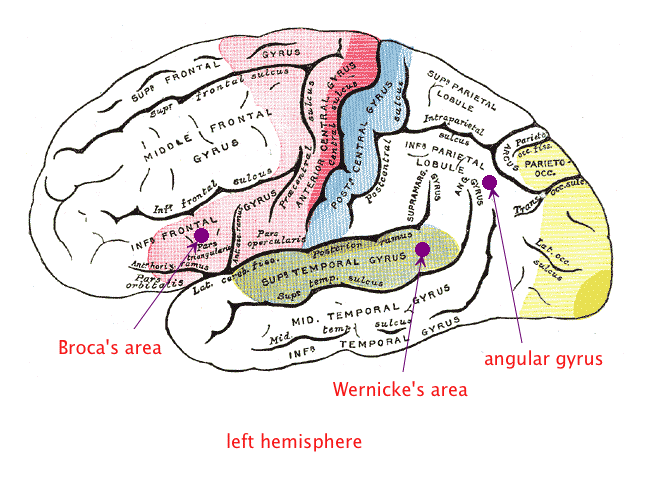The Cerebrum
Dr. C. George Boeree
The Cerebrum
Dr. C. George Boeree
The cerebrum -- which is just Latin for "brain" -- is the
newest (evolutionarily) and largest part of the brain as a whole.
It is here
that things like perception, imagination, thought, judgment, and
decision
occur.
The surface of the cerebrum -- the cerebral cortex -- is composed of six thin layers of neurons, which sit on top of a large collection of white matter pathways. The cortex is heavily convoluted, so that if you were to spread it out, it would actually take up about 2 1/2 square feet (2500 sq cm). It includes about 10 billion neurons, with about 50 trillion synapses!
The convolutions have "ridges" which are called gyri (singular: gyrus), and "valleys" which are called sulci (singular: sulcus). Some of the sulci are quite pronounced and long, and serve as convenient boundaries between four areas of the cerebrum called lobes.
The furthest forward is the frontal lobe (from the Latin
word
for forehead). It seems to be particularly important: This
lobe is responsible for voluntary movement and planning and is thought
to be the most significant lobe for personality and intelligence.

At the back portion of the frontal lobe, along the sulcus that
separates
it from the parietal lobe, is an area called the motor cortex.
In
studies
with
brain
surgery
patients,
stimulating areas of the motor
cortex with tiny electrical probes caused movements. It has been
possible for researchers to actually map out the motor cortex quite
precisely.
The lowest portions of the motor cortex, closest to the temples,
control
the muscles of the mouth and face. The portions of the motor
cortex
near the top of the head control the legs and feet.

Behind the frontal lobe is the parietal lobe (from a Latin
word meaning wall). It includes
an area called the somatosensory cortex, just behind the sulcus
separating this lobe from the frontal lobe. Again, doctors
stimulating
points of this area found their patients describing sensations of being
touched at various parts of their bodies. Just like the motor
cortex,
the somatosensory cortex can be mapped, with the mouth and face closest
to the temples and the legs and feet at the top of the head.

At the side of the head is the temporal lobe (from the Latin
word for temple). The special area of the temporal lobe is the auditory
cortex. As the name says, this area is intimately connected
with
the ears and specializes in hearing. It is located near to the
temporal
lobe's connections with the parietal and frontal lobes.
At the back of the head is the occipital lobe. At the very back of the occipital lobe is the visual cortex, which receives information from the eyes and specializes, of course, in vision.
The areas of the lobes that are not specialized are called association
cortex. Besides connecting the various sensory and motor
cortices,
this is also believed to be where our thought processes occur and many
of
our memories are ultimately stored.
If you are interested in more details about the lobes, click here!
If you look at the brain from the top, it becomes immediately obvious that it is split in two from front to back. There are, in fact, two hemispheres, almost as if we have two brains in our heads instead of just one. Of course, these two halves are intimately linked together with an arch of white matter called the corpus callosum.
In various ways, researchers have discovered that the two halves do have some specialization. It is the left hemisphere that relates to the right side of the body (generally), and the right hemisphere that relates to the left side of the body. Also, it is the left hemisphere that usually has language, and seems to be primarily responsible for similar systems such as math and logic. The right hemisphere has more to do with things like spatial orientation, face recognition, and body image. It also seems to govern our ability to appreciate art and music.
Some of the most interesting work done concerning the two hemispheres was done by Roger Sperry. He worked with people who had had a pretty serious operation to control their epilepsy. It seems that, in some cases, severe epilepsy could be nearly eliminated by cutting the corpus callosum. In a sense, these people really did have two brains (or cerebrums, to be accurate)!
For example, Sperry found that if he put something in the right hand of one of these people after they had their operation, they could say what it was. But if he put it in their left hand, they could not. This is easy to understand: The feeling of the thing in the right hand goes to the left hemisphere and, since that's the side with language, the person could say what it was. The feeling of the thing in the left hand, though, went to the right hemisphere, which can't do much talking.
The eyes are hooked up to the hemispheres in a somewhat complicated way: The right hand side of each retina (which sees things to the left of a focus point) goes to the right hemisphere, and the left hand side of each retina (which see things to the right) goes to the left hemisphere. What this means is that, if you have someone stare at a focus point and briefly show them something on the left, it is the right hemisphere that receives the information. If you show them something on the right, it is the left hemisphere that receives the information.
Sperry would flash things on a projection screen and ask the patients to either say what they saw or pick what they saw with one hand or the other from a box full of things. So, if he showed a ball on the left side of the screen and a pencil on the right, the person would say "pencil" (using the left hemisphere's speech centers) but pick a ball from the box with his or her left hand (using the right hemisphere)!
There were many interesting anecdotes that came out of his research. For example, it turns out that, though the left hemisphere has speech, it is pretty bad at drawing. The right hemisphere, controlling the left hand, could still draw quite well.
He had the patients try little puzzles. One man, struggling to do the puzzle with his right hand, couldn't keep his left hand from trying to jump in to help!
With one young woman, he flashed a picture of a naked man on the
right
side of the screen. She blushed and giggled, but when asked,
couldn't
say why. Of course, only the right hemisphere had seen the
picture,
and the left hemisphere had not!
Fortunately for these people, these situations don't come up much in
ordinary life, so they didn't feel terribly confused most of the
time. Most of us, of course, have an intact corpus callosum, and
the two halves of our brains are in constant communication.
So, speech is predominantly a function of the left hemisphere.
Actually,
the right hemisphere does have a little bit of speech, too: It
has
a good grasp of names and curse words! In addition, if you have
brain
damage to the left hemisphere early enough in childhood, the right
hemisphere
will take over the speech function. And it seems that there are
some
people who have language on the right or even on both sides.
It is interesting to consider that monkeys and apes appear to
sensitive to calls of their own species in the left hemisphere:
They will turn their right ears towards the sound! Even some song
birds, such as canaries, have hemispheric specialization.
One of the earliest things discovered about the brain were the speech centers. One is called Broca's area, after the doctor who first discovered it. It is located at the bottom of the left frontal lobe. A patient who had had damage to this area lost his ability to speak, which is called expressive aphasia.
Another area is Wernicke's area, which is nearby Broca's area but in the temporal lobe, right next to the auditory cortex. This is where we understand the meaning of speech, and damage to this area will leave you with receptive aphasia, meaning that you will be unable to understand what is being said to you.
Occasionally, someone has damage to the connections between Broca's and Wernicke's areas. This leads to conduction aphasia. Someone with this problem can understand speech just fine, and can produce it as well. They just can't repeat something they just heard!
Another important area is the angular gyrus, just above and
behind
Wernicke's area. It serves as the connection between the language
centers and the visual cortex. If this area is damaged, the
person
will suffer from alexia (inability to read) and agraphia (inability to
write).
